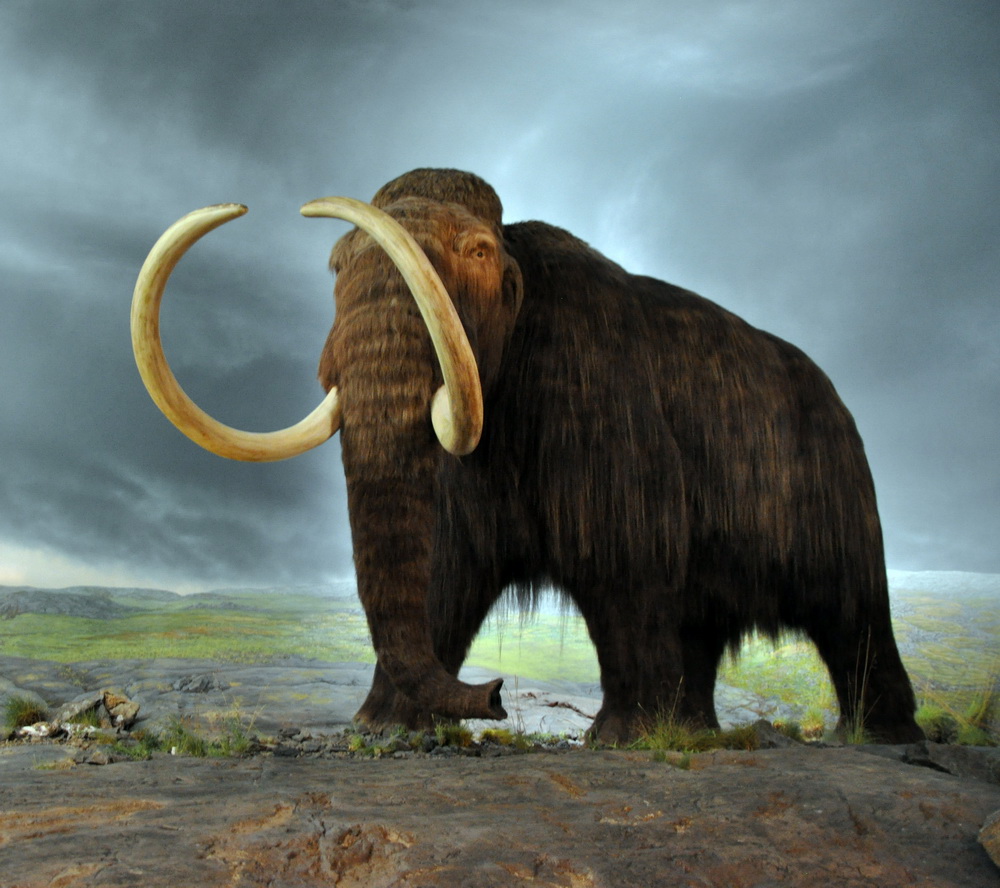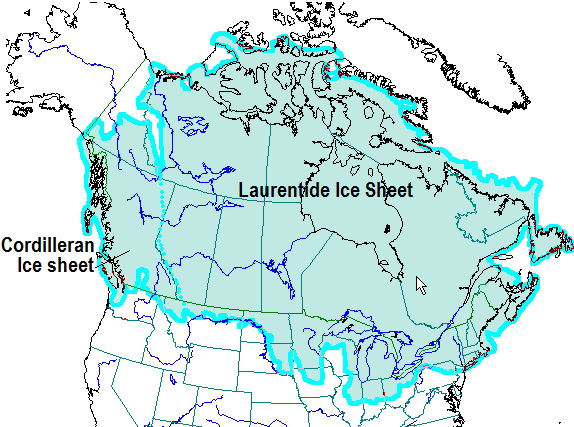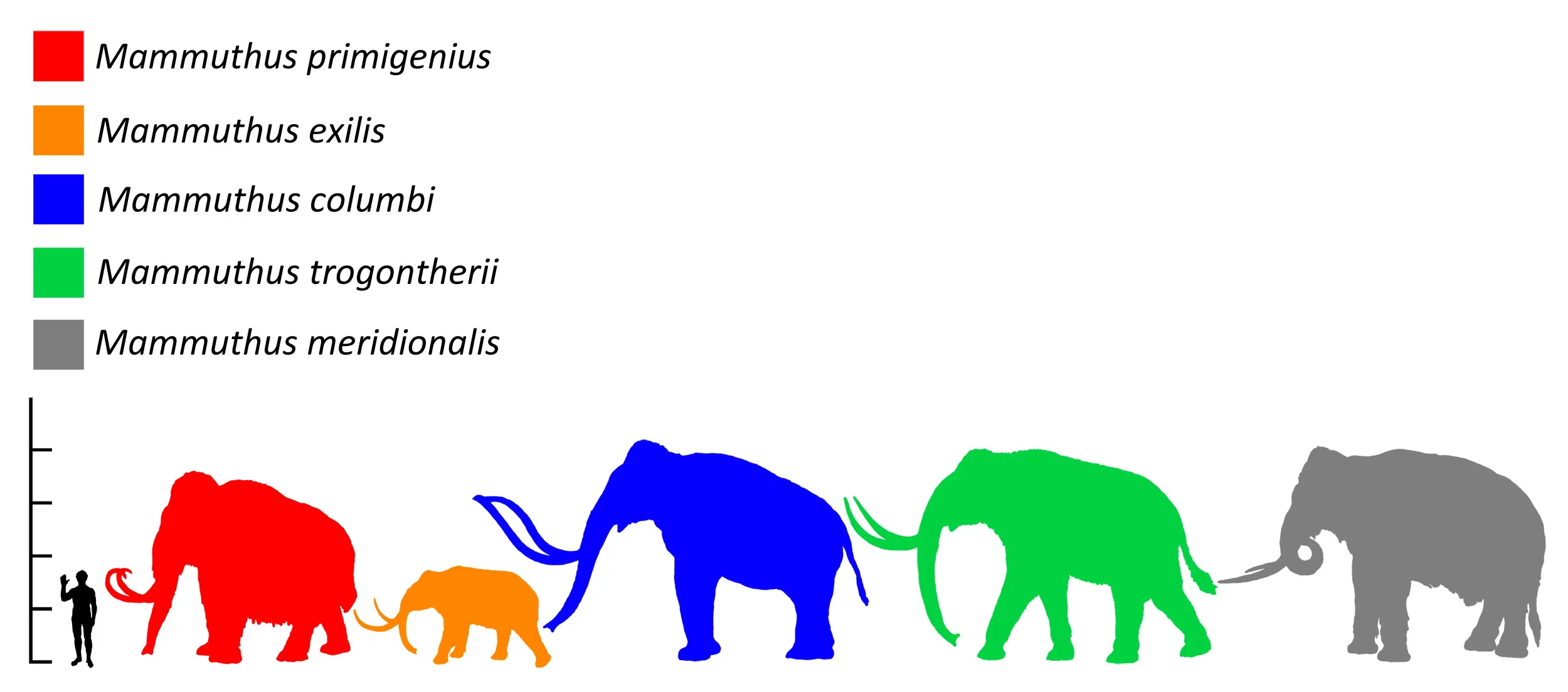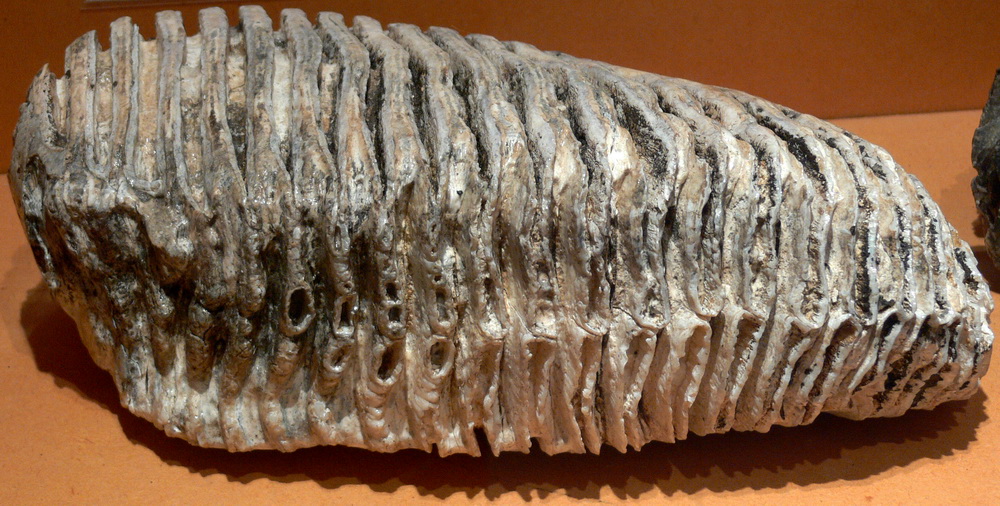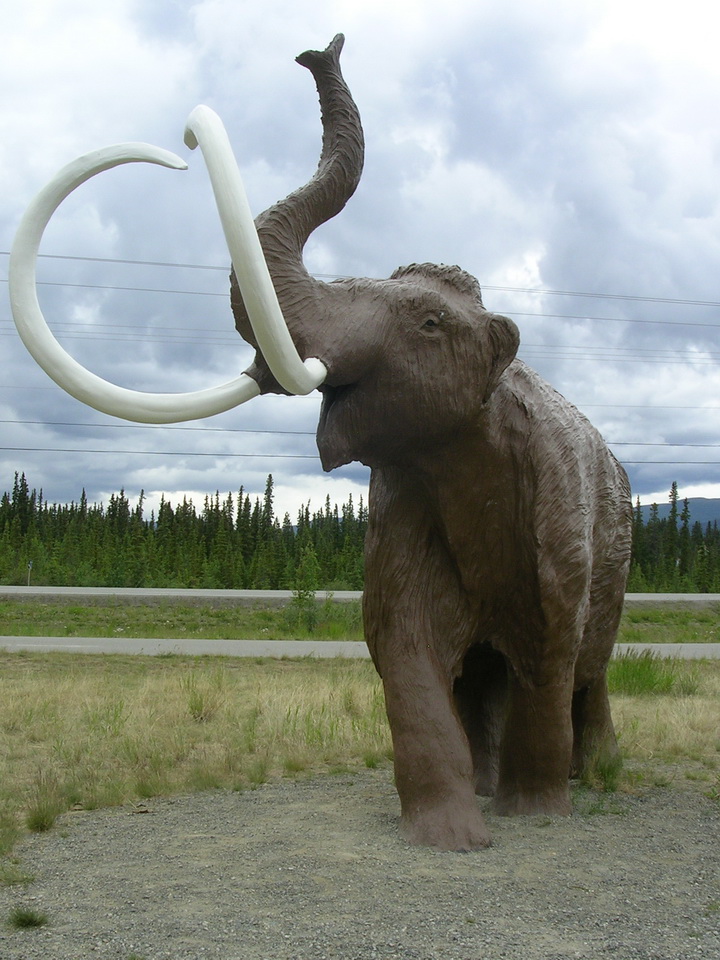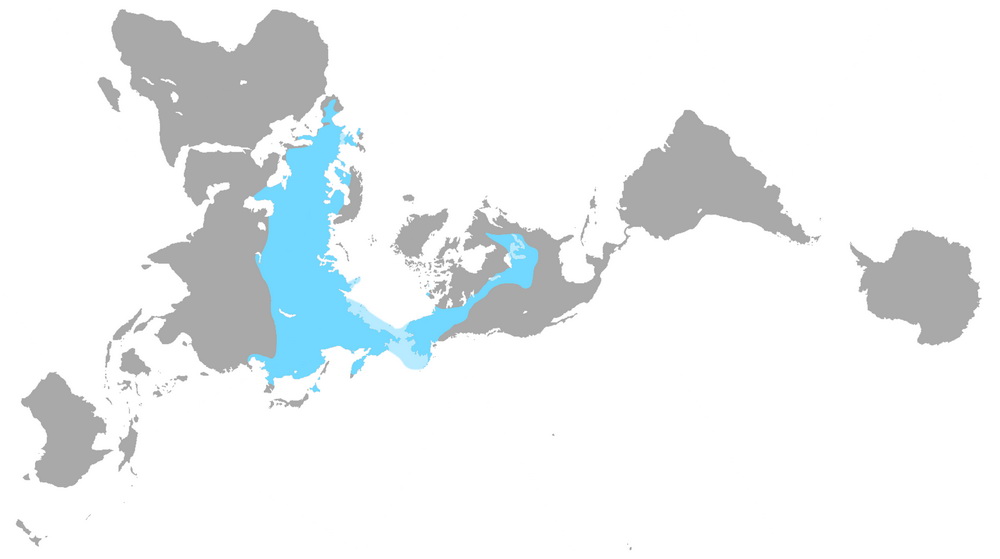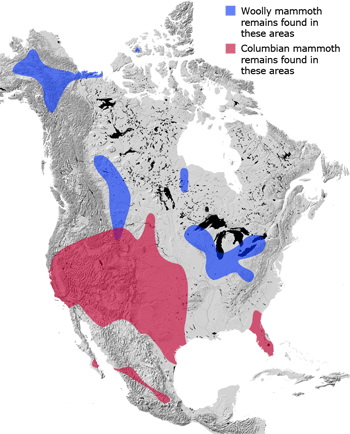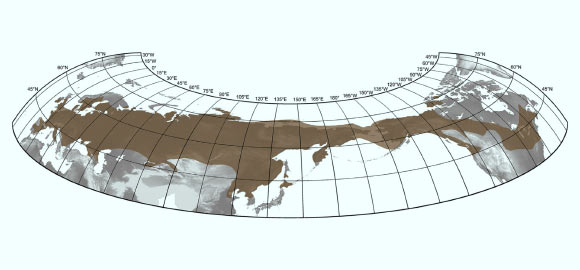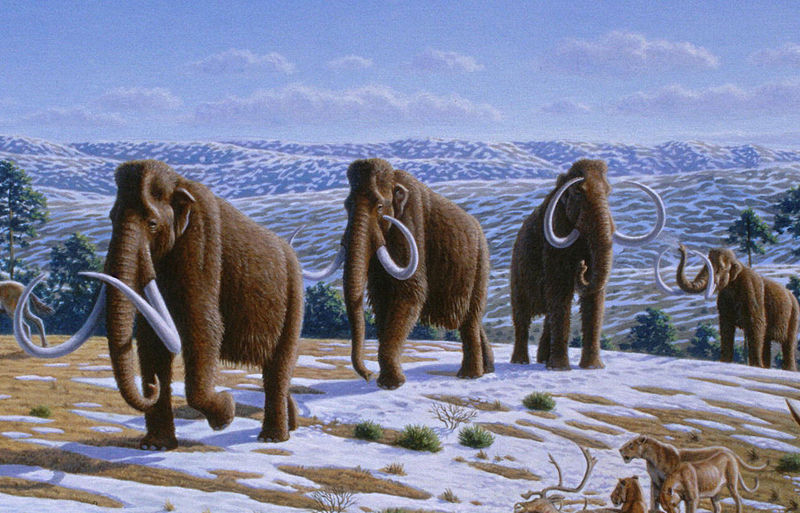Ice Age Mammals - The Woolly Mammoth (Mammuthus primigenius)
Figure 1: A display model of the Woolly Mammoth that was on display in the Royal British Columbia Museum in Victoria (Canada). The display is from 1979, and the fur is musk ox hair.. By Flying Puffin (Mammut Uploaded by FunkMonk) [CC BY-SA 2.0 (http://creativecommons.org/licenses/by-sa/2.0)], via Wikimedia Commons.
Gigantic Elephant-like Animals In Canada?
Can you believe it? Large, furry elephant-like animals, called Woolly Mammoth (Mammuthus primigenius) and American Mastodon (Mammut americanum), lived in Canada, and the rest of North America, during the last ice age (Figure 1). Perhaps you already knew that because you watched one of my favourite Disney movies entitled Ice Age (2002).
During the ice age, large areas of Siberia, Alaska and Yukon were ice-free and joined together by a land bridge. That land was called Beringia. This was part of the land where herds of Woolly Mammoth once roamed (Figure 2). The Woolly Mammoth also roamed across the land further south well into southern United States where the land was also free of ice.
Figure 2: A mural depicting Woolly Mammoths near the Somme River, France. Image made public in 1916, according to the book Charles R. Knight: The Artist Who Saw Through Time: http://io9.gizmodo.com/5891441/celebrating-charles-r-knight-the-artist-who-first-brought-dinosaurs-and-megafauna-to-life
I am not an expert on, not is this an exhaustive description of, the Woolly Mammoth. This is the generalized geological story of the Woolly Mammoth (Mammuthus primigenius), which lived in Canada until about 12,000 years ago.
The Woolly Mammoth was a majestic animal. It looked like a large, furry African elephant (Figures 1 and 2). A lot is known about the appearance and behaviour of the Woolly Mammoth because carcasses have been discovered in Siberia and Alaska, frozen in the permafrost. Also, skeletons, teeth, stomach contents, dung, and prehistoric cave paintings give important insights to this ice-age majestic megafauna animal!
If you are interested in the difference between the Woolly Mammoth and the Mastodon, both of which roamed the land together, check out this Mental_floss article or the Youtube video by Daniel Fisher.
The Last Ice Age
The last great ice started about 2,580,000 years ago. We are presently in a warm period, called an interglacial period, that started about 10,000 to 15,000 years ago. During this warm period, most of the ice sheets from the last glacial period melted away. The remains of the last glaciers cover about 10% of the Earth's land surface. These remaining glaciers still cover Greenland, parts of the Arctic, Antarctica and mountainous regions.
At the peak of the last ice age, about 25,000 years ago, almost all of Canada and ALL of Ontario were covered by ice that was as much as 2 to 3 km thick (Figure 3). The land called Beringia - Siberia, Alaska, and part of Yukon - was ice-free. In Ontario, the ice started to melt for the last time about 18,000 years ago and all of Ontario was free of ice by about 8,000 years ago.
Figure 3: This cartoon shows the coverage across North America of glacial ice during the peak of the last age, called the Wisconsin Glaciation, about 15,000 years ago. Image from: Physical Geology, Chapter 16.1, Glacial Periods in Earth’s History.
Woolly Mammoth Description
The Woolly Mammoth was one of the giant animals, called megafauna, that lived on the land during and at the end of the ice age (Figure 4). The Woolly Mammoth was about the same size as a modern African elephant. The adult male Woolly Mammoth stood over 3 metres tall (about 10 feet tall) at the shoulder and weighed as much as 6 tonnes or 13,200 pounds. Adult, female Woolly Mammoths stood between 2.5 and 2.9 metres (8.5 to 9.5 feet) at the shoulder and weighed up to 4 tonnes (8,800 pounds). A newborn calf weighed about 90 kilograms (200 pounds).
Figure 4: A cartoon that compares the size of the Woolly Mammoth (red) with humans and other extinct elephant-like animals. Size comparison of mammoth species. Mammuthus primigenius (Woolly Mammoth, extinct, 3.4 m), Mammuthus exilis (Pygmy mammoth or Channel Islands mammoth, extinct, 1.8 m), Mammuthus columbi (Columbian mammoth, extinct), Mammuthus trogontherii (Steppe Mammoth, extinct), and Mammuthus meridionalis (extinct: 4 m). Image from: Sergiodlarosa [Public domain, GFDL (http://www.gnu.org/copyleft/fdl.html), CC-BY-SA-3.0 (http://creativecommons.org/licenses/by-sa/3.0/), FAL, GFDL (http://www.gnu.org/copyleft/fdl.html) or CC BY 3.0 (http://creativecommons.org/licenses/by/3.0)], via Wikimedia Commons
The Woolly Mammoth was covered with thick fur and had small ears and a short tail. This fur was similar to that of muskoxen. The hair consisted of long, dark, guard hairs up to 90 cm long in adults, which covered the fine underlying woolly hair. These physical features enabled the Woolly Mammoth to retain body heat and avoid frostbite during the cold periods in the far northern areas. The trunk of the Woolly Mammoth was a little shorter compared to the African elephant (Yukon Beringia detailed fact sheet - Woolly Mammoth).
The back teeth, or molars, of the Woolly Mammoth are distinctive and help distinguish Woolly Mammoth from the Mastodon. The Woolly Mammoth teeth are covered with parallel, raised ridges (Figure 5), suggesting that the teeth were used as a flat grinding surface used to tear up the tough grasses and sedges that were its main food. Examination of molar teeth from baby Woolly Mammoths found near the community of Old Crow, northern Yukon, suggest that the young nursed on their mothers' milk until about three years of age (Yukon Beringia detailed fact sheet - Woolly Mammoth).
Figure 5: Molar tooth from a Woolly Mammoth. The design of the tooth indicates that it was used to grind the grasses and sedges that the animal ate. Image from: By Remi Mathis (Own work) [CC BY-SA 3.0 (http://creativecommons.org/licenses/by-sa/3.0)], via Wikimedia Commons
Another distinctive feature of the Woolly Mammoth was its large curved tusks (Figure 6). For a large adult, the tusks were more than 4 metres long (13 feet) and weighed more than 100 kilograms (220 pounds) each. Scientists suggest that the tusks could have been used to show how big and powerful the animal was, perhaps during mating season, or to defend itself, or to sweep away snow that covered grasses and sedges during the winter (Yukon Beringia detailed fact sheet - Woolly Mammoth).
Figure 6: A statue of a Woolly Mammoth outside the Yukon Beringia Interpretative Centre, Whitehorse. Note the distinctive curved tusks. Photo by E. Ginn, June 29, 2007.
Two other features of the Woolly Mammoth provide insight to cold-tolerance. A thick layer of fat beneath the skin provided additional insulation for the animal to help it tolerate cold temperatures. In addition, Woolly Mammoths had developed a special type of blood hemoglobin that helped the animal tolerate the very cold temperatures, which were typical of the ice age.
Woolly Mammoths from Alaska and Yukon had a larger cousin called the Columbian Mammoth (Mammuthus columbianus), which lived further south, primarily in the United States. The Woolly Mammoth and the Columbian Mammoth appear to have bred with each other in the areas where they lived together (Yukon Beringia detailed fact sheet - Woolly Mammoth).
Location Of Woolly Mammoth Remains
The range of the Woolly Mammoth has been defined by the locations where carcasses frozen in permafrost, bone and teeth remains, and cave drawings have been discovered. It is thought that Woolly Mammoths lived in two groups, which lived in different types of areas. One group lived in the middle of the high Arctic, while the other woolly mammoth group lived over a much larger range.
The best preserved Woolly Mammoth remains come from areas of permafrost in Siberia and Alaska. These remains, sometimes complete with fur, have been found where the melting permafrost released largely intact Woolly Mammoth animals! One estimate suggests that as many as 25,000 Woolly Mammoth carcasses have been found in Siberia since the year 1808 (see the book entitled "Ice Age Mammals of North America", by Ian Lange). One remarkably preserved Woolly Mammoth was recently discovered as a frozen carcass in a remote part of Siberia in 2013. This animal has been the subject of a video entitled "Woolly Mammoth: The Autopsy" and much international research on that carcass has advanced our understanding of the animal.
In addition, the Woolly Mammoth is often represented in drawings made by ancient people, called Paleolithic People, on the walls of caves in Europe (for example, the Rouffignac Cave, France). European cave drawings are estimated to be between 30,000 and about 7,800 years old. These cave drawings tell us that the people who lived in the cave areas must have lived near Woolly Mammoths. In general, the Woolly Mammoth lived across Europe, Ireland, England to Spain, Asia, Siberia and in addition to parts of North America (Figure 7; Beringia Research Note - Woolly Mammoth).
Figure 7: Distribution of Woolly Mammoth (Mammuthus primigenius) during the last great ice age, called the Late Pleistocene. The distribution is based on discovered fossil remains. The lighter blue regions were land during the Late Pleistocene. At that time, sea level was lower because a lot of ocean water was converted to glacial ice. Adapted from Álvarez-Lao, et al. (2009).. Image from: By Azcolvin429 - Own work, CC BY-SA 4.0, https://commons.wikimedia.org/w/index.php?curid=53336204
For the North American range, different maps show some differences in the range of the Woolly Mammoth (Figure 8 and 9). In Canada, based on the distribution of remains, the Woolly Mammoth lived in the ice-free areas of Yukon, British Columbia, Alberta, Saskatchewan, Manitoba and southern Ontario (Figure 8 and 9). The Woolly Mammoth could have lived in other areas across Canada, but that has not been confirmed by the discovery of Woolly Mammoth remains. In Ontario, most of the Woolly Mammoth remains have been found in the southern part of the province (see The University of Waterloo up-to-date map of documented Mastodon and Woolly Mammoth locations in Ontario). Although two Mastodon teeth have been found in the Ontario James Bay Lowlands, no Woolly Mammoth remains have been documented, in place, across northern Ontario. I am cautious to say "none have been found in Ontario's Far North", because I was shown what appears to be a Woolly Mammoth tooth while visiting a remote First Nation community in Ontario's Far North. The details of the location of that tooth were not shared with me.
In Manitoba, the most northerly discovery of Woolly Mammoth remains is a tooth that was found near the town of Bird, south of the Port Nelson / York Factory area, Manitoba (Figure 8; Erik Nielsen, C. S. Churcher, G. E. Lammers (1988): A woolly mammoth (Proboscidea, Mammuthus primigenius) molar from the Hudson Bay Lowland of Manitoba; Canadian Journal of Earth Sciences, 1988, 25(6): 933-938, 10.1139/e88-092). It is likely that this tooth had moved after the animal died, so the exact location and age are uncertain.
In the United States, Woolly Mammoth remains have been found in the southern Great Lakes region and other parts of the northeastern states (Figure 8 and 9: Yukon Beringia detailed fact sheet - Woolly Mammoth). The related Columbian Mammoth lived in the southern parts of United States (Figure 8 and 9; Beringia Research Note - Woolly Mammoth).
Figure 8: Generalized locations of mammoth remains across North America. Although more localized in nature, this image is interesting because it shows Woolly Mammoth remains have been found south of the Port Nelson / York Factory area, Manitoba. Image from the Children's Discovery Museum of San Jose.
Figure 9: The maximum distribution of Woolly Mammoth species across North America, Asia, and Europe. Image from "Paleontologist Releases Most Accurate Map Yet of Woolly Mammoth Distribution".
Age Of Woolly Mammoth Remains
The Woolly Mammoth tooth found near Bird, Manitoba, may be between 75,000 and 125,000 years old. We must be cautious with this age because the tooth was found loose on river gravel. Because the Bird specimen tooth was not found in place, there is uncertainty about its age. A partially preserved Woolly Mammoth jaw found in Yukon is about 30,000 years old (Yukon Beringia detailed fact sheet - Woolly Mammoth). Geologists measured an age of 21,000 years old for well preserved Woolly Mammoth remains found in Alaska (Yukon Beringia detailed fact sheet - Woolly Mammoth).
The last of the Woolly Mammoths in Canada disappeared from Yukon around 12,000 years ago, towards the end of the last great ice age (Yukon Beringia). But this was not the end of Woolly Mammoth in the Arctic region. An isolated population of Woolly Mammoth lived on St. Paul Island, Alaska, until about 5,600 years ago and a different population lived on Wrangel Island, in the Siberian Sea, north of Siberia, between 7,000 and 3,700 years ago (Yukon Beringia detailed fact sheet - Woolly Mammoth).
What Habitat Did The Woolly Mammoth Live In?
Based on the geology of the material that contains Woolly Mammoth remains and the physical features of the mammoth remains, it appears that the Woolly Mammoth lived in, and was adapted to, cold climate steppe areas across northern Eurasia and North America (Figure 10). In North America, such areas included tundra, tundra-boreal forest margins, and cold loess-steppe areas. The loess-steppe environment formed where fine windblown dust material accumulated on the land surface at the edge of the glacier (Yukon Beringia detailed fact sheet - Woolly Mammoth).
Figure 10: Woolly Mammoth in what is believed to have been the cold-temperature steppe habitat typical of the Arctic regions in Siberia, Alaska and part of Yukon (Beringia) during the last ice age. Image created by Mauricio Anton, Creative Commons license.
What Did The Woolly Mammoth Eat?
The Woolly Mammoth tooth design suggests that it was an herbivore. That means it ate vegetation. It did not eat meat. The Woolly Mammoth ate mostly tough tundra plants, such as grasses, twigs, and bark (see the book entitled "Ice Age Mammals of North America", by Ian Lange). It is estimated that an adult Woolly Mammoth could eat as much as consumed 200 kilograms of food each day. From a DNA study of Yukon plants found in the permafrost during the ice age, researchers determined that the Arctic landscape was not a barren, grassy prairie. It was a land that was covered by small, nutritious flowering plants called forbs, like poppies, buttercups, and anemones. The nutritious forbes would have served as an important food source for the large Woolly Mammoths.
Is The Woolly Mammoth Related To The Modern Elephant?
Recent Woolly Mammoth DNA analysis, completed in year 2015, indicates that it is genetically closely related to the Asian elephant (Elephas maximus).
Why Did Woolly Mammoth Go Extinct?
Woolly mammoths, like many giant animals of the Ice Age, became extinct at the end of the last ice age, between 12,000 and 4,000 years ago (Yukon Beringia detailed fact sheet - Woolly Mammoth), depending on the location.
During the last 100,000 years, about 36 genera of ice age mammals, or about 70% and 75% of all ice age mammals in North America, went extinct (J. Tyler Faith, 2011 and Ian M. Lange). You can think of the word "genera" to refer to a type of animal, like a dog. Within that genera of animal, like dogs, there are many different species of dog, such a Labrador retriever and Chihuahua.
Interestingly, the extinctions were greatest for the largest of the megafauna, larger than 1000 kg (Ian M. Lange); however, over half the mammal genera that weighed between 32 and 1000 kg also went extinct (see the summary by J. Tyler Faith (2011). Smaller mammals went extinct at the same time. The bulk of these extinctions took place towards the end of the last great ice age, between 25,000 and 10,000 years ago (Yukon Beringia).
A complete and detailed discussion of all extinction theories is beyond the scope of this note; however, several ideas have been suggested to explain the extinctions of the ice age mammals towards the end of the ice age (see summary by Tyler Faith, 2011 and Ian M. Lange): a) climate change, such as the impact of periodic warm and very cold periods, toward the end of the ice age; b) change in nutritional quality, types, and range of vegetation eaten by megafauna in an area due to climate change and/or change in the soil nutrients; c) change in the geographic range of animal communities; d) increased burning of vegetation; e) the arrival of Clovis hunter - gatherers in North America, who would have hunted the megafauna to extinction; and f) a very controversial idea that extinction was caused by an extra-terrestrial impact event.
Regarding the woolly mammoth, it did coexist with early humans. We know from archaeological finds that the humans used the Woolly Mammoth bones and tusks for making art, tools, and dwellings. The humans also hunted Woolly Mammoth for food. So, it is possible that human hunting was partly a factor that contributed to the extinction.
Alternatively, or perhaps in addition to human hunting, many researchers believe that the main reason for the Woolly Mammoth extinction was was the dramatic rise in temperature at the end of the ice age. There is excellent evidence that in Yukon, the temperature did rise dramatically about 10,000 years ago - the time when a mass extinction of the megafauna took place. Such a temperature rise would have dramatically affected, and changed, the vegetation that the Woolly Mammoth needed as their food.
The Woolly Mammoth and Aboriginal Oral Tradition
I am not an expert on Aboriginal oral tradition, but I have been privileged to listen to some oral stories shared with me by my First Nation friends. I am struck by the parallels between the First Nation oral recounts of geological and other land-related understandings and my understanding of the land seen through my geological eyes.
Do stories of the Woolly Mammoth exist in Aboriginal oral tradition? If so, what do those oral accounts tell us about life with the Woolly Mammoth? There is evidence that First Nation ancestors in North America lived with and hunted the Woolly Mammoth. For many reasons, it is instructive to become familiar with these First Nation oral traditions.
Here is a partial list of links to some Aboriginal oral traditions about the Woolly Mammoth. I share these links with respect so that we may benefit from the lessons, insights, and geological and land-related references that are wrapped up in the Aboriginal oral traditions:
Big Bone Lick State Historic Site – Historic Pocket Brochure Text: An oral tradition by the Delaware Indians about the origins of the mammoth and mastodon bones at Big Bone Lick. Note, there is some culturally harsh quotations in this text.
Big Quisquis (meaning " hog " in modern Iroquois): summarized in "Native American Legends of the Woolly Mammoth" (2013): David Cusic, the Tuscarora Indian, in his history of the Iroquois spoke of the Big Quisquis, which was a terrible monster that invaded the Indian settlements by Lake Ontario, and was at length driven back by the warriors from several villages after a severe engagement;
Oyahguaharb: summarized in "Native American Legends of the Woolly Mammoth" (2013): Elias Johnson, the Tuscarora chief, in his "History of the Six Nations" is said to have spoke of a monster that appeared at an early period in the history of his people. The monster was called Oyahguaharb and is supposed to be a great mammoth who was furious against men. Oyahguaharb destroyed the lives of many Indian hunters, but the monster was eventually killed after a long battle.
W. D. Strong (1934): North American Indian Traditions Suggesting a Knowledge of the Mammoth, in American Anthropologist.
George E. Lankford (1980): Pleistocene Animals in Folk Memory; The Journal of American Folklore, Vol. 93, No. 369 (Jul. - Sep., 1980), pp. 293-304.
Legendary Native American Figures: Katshituashku, the Stiff-Jointed Bear (or Misi-Maskwa): Some people believe this creature may have referred to mammoths or mastodon fossils.
Tshakapesh and the Elephant Monster: An Innu oral tradition about the culture hero fighting the monster Katcheetohuskw.
Science Fiction Or The Future: Clone A Woolly Mammoth?
Believe it or not, there are efforts to use DNA extracted from a Siberian Woolly Mammoth carcasses and other DNA genetic methods to clone a Woolly Mammoth. This topic is way beyond the scope of this note, but it makes for interesting science and ethical speculation.
Summary
Ontario, and other parts of North America, Asia and Europe, were once the home of the ice age mammal called the Woolly Mammoth (Mammuthus primigenius). It is one of the giant animals, called megafauna, that lived in North America during, and immediately after, the last great ice age. The Woolly Mammoth was a giant on the North American land. It appears to have originated in Asia and crossed into North America across the Beringia land bridge that connected Siberia with Alaska and Yukon. The Woolly Mammoth was about the same size as a modern African elephant. The adult male Woolly Mammoth stood over 3 metres tall (about 10 feet tall) at the shoulder and weighed as much as 6 tonnes or 13,200 pounds. It lived on cold steppe grasslands close to the glaciers, where it ate tough grasses and sedges.
Reference to the Woolly Mammoth appears in some Aboriginal oral traditional stories that reference the land. It would have been an exciting moment for our ancient human ancestors to have encountered, and even hunted, the Woolly Mammoth.
The last of the Woolly Mammoths in Canada disappeared from Yukon around 12,000 to 10,000 years ago, towards the end of the last great ice age. An isolated population of Woolly Mammoth lived on St. Paul Island, Alaska, until about 5,600 years ago and a separate population lived on Wrangel Island, in the Siberian Sea, north of Siberia, between 7,000 and 3,700 years ago. It appears that a combination of human hunting and climate change related to the dramatic rise of temperature at the end of the ice age, about 10,000 years ago, both contributed to the extinction of the Woolly Mammoth.
So, the next time you walk over the land, think about the time during and following the last great ice age when the giant Woolly Mammoth also walked on the Ontario Beneath Our Feet!
Andy Fyon, April 6, 2017.

